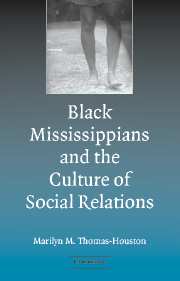Book contents
- Frontmatter
- Contents
- Preface
- Acknowledgments
- Introduction
- PART ONE THE CULTURAL HISTORY AND SOCIAL STRUCTURE OF THE REGION
- PART TWO SOCIAL CONSCIOUSNESS, SOCIAL ACTION
- PART THREE CONSTRUCTION OF AN INTRARACIAL IDENTITY
- Conclusion
- Appendix A Lafayette County Population Chart
- Appendix B Proclamation Honoring Ole Miss Demonstrators
- Appendix C Chancellor's Statement of Commendation
- Appendix D Speech by Susie Marshall for Second Baptist Church Honoring Rev. Blind Jim Ivy
- Appendix E Susie Marshall's Unpublished Draft of Freedman Town Marker Dedication Speech Recounting July 4, 1867, Speech of Oxford Ex-slave
- Bibliography
- Index
Introduction
Published online by Cambridge University Press: 23 December 2009
- Frontmatter
- Contents
- Preface
- Acknowledgments
- Introduction
- PART ONE THE CULTURAL HISTORY AND SOCIAL STRUCTURE OF THE REGION
- PART TWO SOCIAL CONSCIOUSNESS, SOCIAL ACTION
- PART THREE CONSTRUCTION OF AN INTRARACIAL IDENTITY
- Conclusion
- Appendix A Lafayette County Population Chart
- Appendix B Proclamation Honoring Ole Miss Demonstrators
- Appendix C Chancellor's Statement of Commendation
- Appendix D Speech by Susie Marshall for Second Baptist Church Honoring Rev. Blind Jim Ivy
- Appendix E Susie Marshall's Unpublished Draft of Freedman Town Marker Dedication Speech Recounting July 4, 1867, Speech of Oxford Ex-slave
- Bibliography
- Index
Summary
FIRST CONTACT: DOESN'T EVERYBODY OWN A TV?
While traveling west along a beautiful tree-lined street of postbellum homes in Oxford, Mississippi, I observed what I thought to be a disturbing example of the quality of race relations in this quiet university town. A Black man, about 75 years old – driving approximately twenty-five miles per hour – was traveling in front of me along the same side street. Although the light changed from red to green a few seconds or so before the elderly gentleman arrived at the intersection, he stopped. Puzzled by his stopping, I tried to see what was wrong. I saw the vehicle on the cross street come to a stop as well, and knew the problem wasn't traffic. He then beckoned for the car – driven by an elderly White woman, in her late 70s or early 80s – to continue across. My “big city” impatience and “middle-class” self-importance induced me to blast my horn. To my dismay, the “gentleman” waited and the “lady” – after a couple of moments of thought – proceeded across against the light. “We don't have to live like this anymore,” I thought while witnessing the unfamiliar show of deference in this Black–White/male–female interaction. “This is 1983,” almost twenty years after the Civil Rights Movement (CRM) brought an end to the Jim Crow period in the state and federal troops supported the integration of the University of Mississippi.
- Type
- Chapter
- Information
- 'Stony the Road' to ChangeBlack Mississippians and the Culture of Social Relations, pp. 1 - 24Publisher: Cambridge University PressPrint publication year: 2004

